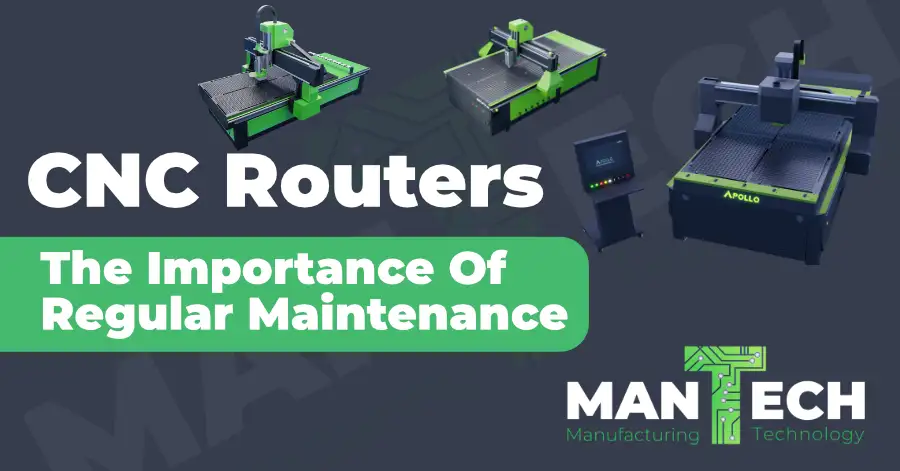CNC Router Machines – The Importance Of Regular Maintenance

CNC Router Maintenance Guide 2025–2026
Why Regular Maintenance Is Essential for Accuracy, Reliability & Machine Lifespan
CNC routers are long-term investments. Whether you’re routing timber, plastics, composites or aluminium, consistent maintenance is the key to accuracy, performance, and reduced downtime. This updated 2025–2026 guide explains everything you need to know to keep your machine running at peak performance.
Introduction
Modern CNC routers contain precision components—ball screws, linear rails, spindles, servos, extraction systems—and like any high-performance machine, they rely on regular preventative maintenance.
Even industrial-grade systems such as the Mantech Spartan, Apollo and Odyssey Series require consistent care to protect accuracy and extend working life.
Improved Cutting Accuracy
Clean rails, lubricated drives and aligned spindles ensure precise cuts and smooth edges.
Reduced Downtime
Most breakdowns are caused by preventable issues—neglected lubrication, loose couplings, clogged extraction and worn collets.
Extended Machine Lifespan
Proper maintenance can add 5–10 years to the life of your CNC router.
Safer Operation
A clean, well-maintained machine reduces the risk of fires, tool breakages and spindle overloads.
Daily CNC Router Maintenance
- Lubricate linear rails and bearings
- Check oil levels on auto-lube systems
- Tighten gantry bolts, couplings and drive mounts
- Clean and inspect dust extraction system
- Inspect worn or dirty spindle collets
Monthly CNC Router Maintenance
- Verify spindle tram and alignment
- Check ball screws & rack/pinion wear
- Inspect belts for tension and wear
- Clean electrical cabinet (low pressure)
- Check servo tuning & responsiveness
Annual Maintenance
Annual maintenance should ideally be carried out by a trained CNC technician.
Core annual tasks include:
- Full axis alignment & calibration
- Spindle health and bearing checks
- Firmware and controller updates
- Purging and replenishing lubrication systems
- Replacement of worn components (collets, brushes, filters, bearings)
- Checking extraction, pneumatics and electrical systems
This keeps your machine running at manufacturer-level accuracy.
Common Problems When Maintenance Is Ignored
Common symptoms include:
- Inconsistent cutting depth
- Vibration, chatter or stepping
- Rough or burn-marked edges
- Gantry racking
- Servo following errors
- Spindle overheating
- Excess tool breakage
- Excessive dust inside electronics
Preventive care avoids 90% of these issues.
Air Cutting & Compressed Air
Clean, dry compressed air is essential for CNC routers, especially those using pneumatic clamps, ATC systems, or high-volume dust extraction.
Maintenance Logs
Keeping a machine log helps track usage, detect patterns, and ensure accountability in multi-operator environments.
Include fields for:
Include fields for:
Operator
Hours run
Maintenance tasks completed
Issues noticed
Parts replaced
CNC Router Servicing
Mantech Machinery provides nationwide CNC router servicing, annual tune-ups, breakdown support, spindle servicing, controller upgrades and on-site training.
Whether you operate a single machine or a full production line, our engineers ensure your CNC router stays accurate, reliable and production-ready.
CNC Machines
CNC Routers




